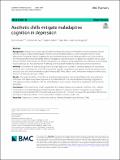Aesthetic chills mitigate maladaptive cognition in depression
Author(s)
Schoeller, Felix; Jain, Abhinandan; Adrien, Vladimir; Maes, Pattie; Reggente, Nicco
Download12888_2023_Article_5476.pdf (1.173Mb)
Publisher with Creative Commons License
Publisher with Creative Commons License
Creative Commons Attribution
Terms of use
Metadata
Show full item recordAbstract
Background
Depression is a major global health challenge, affecting over 300 million people worldwide. Current pharmacological and psychotherapeutic interventions have limited efficacy, underscoring the need for novel approaches. Emerging evidence suggests that peak emotional experiences characterized by awe, transcendence, and meaning hold promise for rapidly shifting maladaptive cognitive patterns in depression. Aesthetic chills, a peak positive emotion characterized by physical sensations such as shivers and goosebumps, may influence reward-related neural pathways and hold promise for modifying core maladaptive beliefs rooted in early adverse experiences.
Methods
We enrolled 96 patients diagnosed with major depressive disorder. A validated database of multimedia known to elicit chills responses (ChillsDB) was used for stimulus presentation. Participants’ emotional responses were assessed using the Emotional Breakthrough Inventory (EBI), while shifts in self-schema were measured via the Young Positive Schema Questionnaire (YSPQ).
Results
The study found that chill-inducing stimuli have the potential to positively influence the core schema of individuals with depression, impacting areas of self-related beliefs. The associated phenomenology triggered by chills appears to share similarities with the altered states of consciousness induced by psychedelic substances like psilocybin.
Conclusions
These preliminary results suggest that the biological processes involved in aesthetic chills could be harnessed as a non-pharmacological intervention for depression. However, further investigation is necessary to comprehensively understand the neurophysiological responses to chills and to evaluate the practicality, effectiveness, and safety of utilizing aesthetic chills as a preventive measure in mental health care.
Date issued
2024-01-10Department
Program in Media Arts and Sciences (Massachusetts Institute of Technology)Publisher
BioMed Central
Citation
BMC Psychiatry. 2024 Jan 10;24(1):40
Version: Final published version